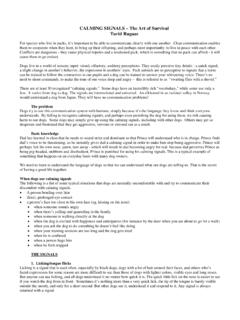Transcription of Basic Hermit Crab Care - hermitcrabassociation.com
1 Basic Hermit crab Care At A Glance An example of a Hermit crab tank: Lifespan: Up to 40 years is possible in captivity though 10 to 20 years is more common. In the wild, 50 to 70 years has been reported. Size: Young crabs (under 2 years) are inches across and can fit on a dime. Full grown adults (25+. years) reach 6 inches and are larger than a softball. Average size (5 to 15 years) is 2 to 3 inches. Housing: Minimum 10 gallon aquarium for small crabs, with larger tanks required as they grow. Minimum 75 gallon aquarium when fully grown. Wire cages and open topped enclosures do not hold in heat or humidity and should not be used in non-tropical areas.
2 Climate: 80 to 85 degrees and humidity levels of at least 75%. Purple Pinchers can handle slightly lower temperatures down to 75 degrees. Substrate: Children's Playsand (silica based) or cocofiber, or a mix of the two, and many crabbers prefer a 5:1 mixture of sand to cocofiber. Must be kept moistened, enough so the substrate keeps its shape when squeezed but not so much it drips. Substrate should be at least three times deeper than the crab is big, which usually means filling the aquarium halfway. Water: Dechlorinated water must be used, and using a product that binds heavy metals is recommended.
3 Water bowls should be deep enough for the crab to submerge with a way for them to safely climb back out. Both fresh and salt is required. Saltwater should only be mixed using a product for marine fish. Diet: Hermit crabs are omnivores and scavengers. Fruit and protein (meat, insects, seafood) should be provided daily. Vegetables and plant matter such as oak or maple leaves are welcome additions. Hermits are affected by pesticides and fertilizers, so care should be taken when sourcing food. Molting: Crabs molt to grow, which can take weeks or months. They will bury under the surface and not return topside until they are finished.
4 This is why there is a need for such deep substrate! Never disturb a molting crab as digging it up may kill it. Shells: 3 to 5 shells per crab , and they must be a proper species of shell and slightly larger than what the crab is currently wearing. Please do not offer painted or glazed shells - they are dangerous and potentially toxic to hermits. Natural and polished shells can be found online and in craft stores. Breeding: Hermits do breed in captivity, but live young are not possible without special equipment and a lot of effort. Maintenance: Food should be changed daily to prevent mold growth.
5 Water bowls should be changed when dirty or at least every third day. Spot clean as needed to remove waste and uneaten food. Glass can be cleaned with white vinegar as needed. Monitor substrate for signs of dryness and spray with freshwater as needed. Substrate almost never needs to be changed unless it becomes over saturated. If the tank is not over saturated and you feel strongly about changing it, please wait until all molting crabs are finished and on the surface for safety! Shopping List (Basics). Hermit Crabs - they need friends Extra Shells natural, the same size and larger than what the crab is currently wearing A Place for Them to Live aquarium, 10.
6 Gallon minimum, based on size and number of Food - natural fruits, insects, meat and crabs seafood A Lid - screen lid w/clips or aquarium lid Food Bowl - or clam shells Heat Source - under tank heater for use on Items to Climb On decorations or back of tank, or heat lamp driftwood Water Dechlorinator for fish or reptile Places to Hide - cocohuts, caves, fake plants Substrate - silica playsand and/or cocofiber Plants for Cover - silk or plastic 2 Water Bowls for salt and fresh - they need Hand Mister - or electric fogger to be deep enough to submerge in Reptile Moss (Optional). Salt Mix made for saltwater fish only Calcium Source - cuttlebone, crushed coral, Thermometer and Hygrometer egg shell I Bought a crab , Now What?
7 ! There are many myths and inaccurate care sheets and advice out there, so please read on! Hermit crabs come from tropical regions; therefore, they have a few easy, yet essential requirements for their home away from home - which we call a crabitat. Once these Basic requirements are met, you will find Hermit crabs to be a relatively simple yet rewarding pet to care for. This care sheet and other articles on our site will help you to understand what those needs are, and will help you to set up a home for your new Hermit crab . Hermit crabs can live for decades with proper care, so giving them the perfect home is important.
8 New Hermit Crabs While the name implies they like to be alone, that is far from the case! In the wild, Hermit crabs travel in colonies that number in the hundreds. Most Hermit crabs benefit greatly from having friends in fact, it's very important for them to have the company of their own kind. You'll also be able to watch them interact, and their behavior in the presence of other crabs is closer to what it would normally be in nature. Size does not matter to a Hermit crab , so feel free to mix tiny crabs with jumbos. crab companions should only be other Hermit crabs though; do not place them in the same enclosure as other reptiles, amphibians, or mammals.
9 A healthy crab can be seen walking and waving its antennae happily, either on its own or when you pick it up (hold your hand flat so it can't pinch!). Crabs in natural shells are usually healthier than crabs that were forced into painted or decorated shells. Most crabs dump their painted shell first chance they get. New crabs can be kept in a separate ISO tank for a few weeks to a month both to help them graduate to the improved conditions, and to prevent introducing crab mites to your current Hermit crabs. Many crabbers choose to add new crabs immediately to their main tank. New crabs should be bathed at least once before upon coming home to make sure they do not have mites.
10 When introducing new crabs to the main tank, give them a dip in tank temperature declorinated fresh water which will make them smell familiar to the other crabs. It can help to prevent any bullying or fights with your existing crabs, and make the introductions go much smoother. All Hermit crabs are wild caught, and not all make the transition from life in the wild to life in captivity. They also take a very long journey from the tropics in less than good conditions to reach the stores where they are sold. Some Hermit crabs will start to slow down and may unexpectedly die after being bought.




